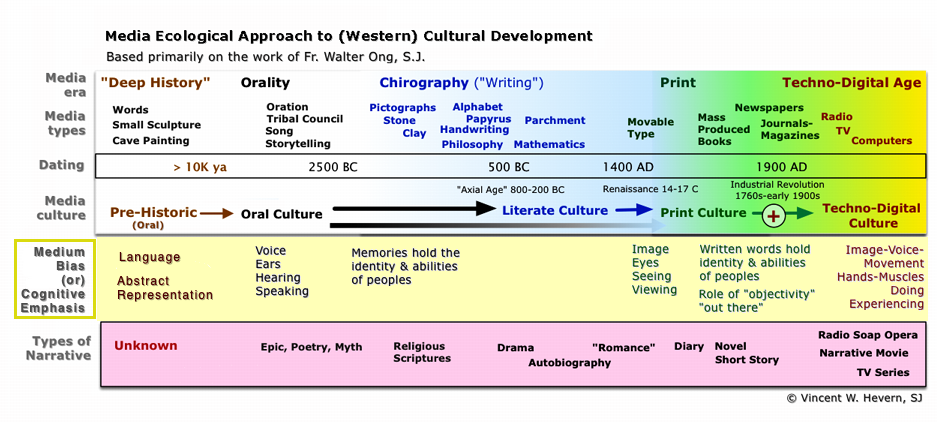This page was last modified on September 11, 2024
PSY 355 Psychology & Media in the
Digital Age
This page was last modified on September 11, 2024 |
The Development of Media from a Media Ecology Perspective
Thought Experiment: A World Without Almost Any Media
- What would life be like?
- How would you make a living? How would you know what to do day by day and season by season?
- How many people do you think would be around in such a circumstance?
- What happens to social groups, bands of people, etc. when some sort of illness or disease quickly spreads throughout the group?
Human History from the Perspective of Media Ecology: from "Deep History" to the Present

Media Eras: (1) "Deep History" (2) Orality (3) Chirography ("Writing"/Literacy) (4) Print (5) Techno-Digital Age
Media Cultures: (1) Pre-History (2) Oral Culture (3) Literate Culture (4) Print Culture (5) Techno-Digital Culture
Some General Principles of the Media Ecological Perspective
1. The media environment -- that is, the tools available to communicate and maintain information -- have a profound effect upon the societies in which human beings live including how they think and how they carry out their daily lives.
2. Media build upon the human sensory-perceptual system and allow people to do things they otherwise could not be able to do.
3. Human beings in later media environments often live in ways that are very different than human beings in earlier media environments.
4. The 'Media Ecology Perspective" argues that each form of a medium has a kind of "bias" or particularly emphasizes some aspect of human cognitive/psychological functions. Bias here does NOT mean anything negative. Rather, "bias" is a form of an inclination or a tendency toward some aspect of reality. Media are seen as favoring or giving a kind of slant toward some aspect of human functions and abilities. In the chart above, I've identified the major medium "biases" that have emerged in each new media era or period.
The World of Primary Orality and Oral Culture
This is the world before human beings invented writing.
In this world human beings depend(ed) upon verbal (oral) communication and memory as the ways of interacting with one another and retaining information.
- The cognitive bias of this world lay with the voice and sound.
- It emphasized careful listening and skillful speaking.
- Fr. Walter Ong, S.J. (Saint Louis University) in his 1982 book Orality and Literacy detailed important characteristics that mark oral cultures (no reading/writing) versus literate cultures (reading/writing exist).
- Building on Ong's work, Dr. Hamid Yeganeh (at Winona State University) has expanded the comparison in helpful ways in a recent (2021) article.
Oral Cultures
Literate Cultures
Concrete
Abstract
Additive
Subordinative
Redundant/Copious
Concise
Emotionally Resonant
Accurate
Homeostatic
Accumulative
Fluid Knowledge
Solid Knowledge
Communal Learning
Individual Learning
Mnemonic
Analytic
Subjective Information
Objective Information
Simple
Complex
Conservative/Traditonalist
Innovative-Exploratory-Changeable
Types of "media" in Oral Culture
- Orations
- Tribal Councils
- Songs, e.g., Iliad (15,693 lines) & Odyssey (12,109 lines) of Homer
- Storytelling, e.g, in Celtic Irish culture the file (poet) or in West African culture, the "griot"
The Development of Writing & Literate Culture
Have you ever heard of "Unicode®" or the Unicode Consortium?
Updated: Sept. 10, 2024 Version 16.0
- 154,998 separate characters
- 168 different scripts (types of alphabets or writing from different cultures)
- Added 5,185 new characters (including 3,995 new hieroglyphs) to Version 15.0
Writing Systems
- Pictorgrams: represents an object
- Ideograms: represent an idea
- Logograms: represents a word or a morpheme (syllable)
- Sumerian cunieform
- Egyptian hieroglyphics
- Chinese Hanzi characters
- Alphabets (ca. 1050 BCE by Phoenicians): represent sounds
![[Alphabet]](../psy355graphics/alphabet.png)
This page was first posted on 2/6/14
Associated Writing Technologies
- Monuments & Wall Inscriptions
- Clay tablets
- Papyrus
- Wax tablets
- Parchment
- Paper
- Manuscripts
- Scroll
- Codex
Chirography's (Writing's) Effects and the Development of Literary Culture
- Chirography ('chiro' = 'by hand" & 'graph' = 'writing')
- Writing was limited to a small percentage of the population
- Writing allows
- (a) recording important data that could be consulted or read again and again in the future
- (b) exchanging important information with others at great distances and being able to monitor events far away
- (c) establishing uniform sets of laws and procedures that might apply to large territories of land
- (d) keeping track of financial transactions and legal ownership of property
- (e) entering into long-term contracts with undisputed evidence of what was agreed to by the parties, etc.
- Thinking itself becomes both more highly internalized
- Since the expression of thought is externalized when put down in writing, it can be examined by others for longer periods of time.
- Historical development of broadly-embraced religions
- Judaism, Christianity, and Islam are all religions "of the Book."
- The Vedas of Hinduism were written in Sanskrit in ca. 1500-500 BC.
- Buddhism, Zoroastrianism, Daoism, Confucism, etc. relied upon a wide range of written texts.
- The written word cannot or has difficulty conveying the prosody of speech